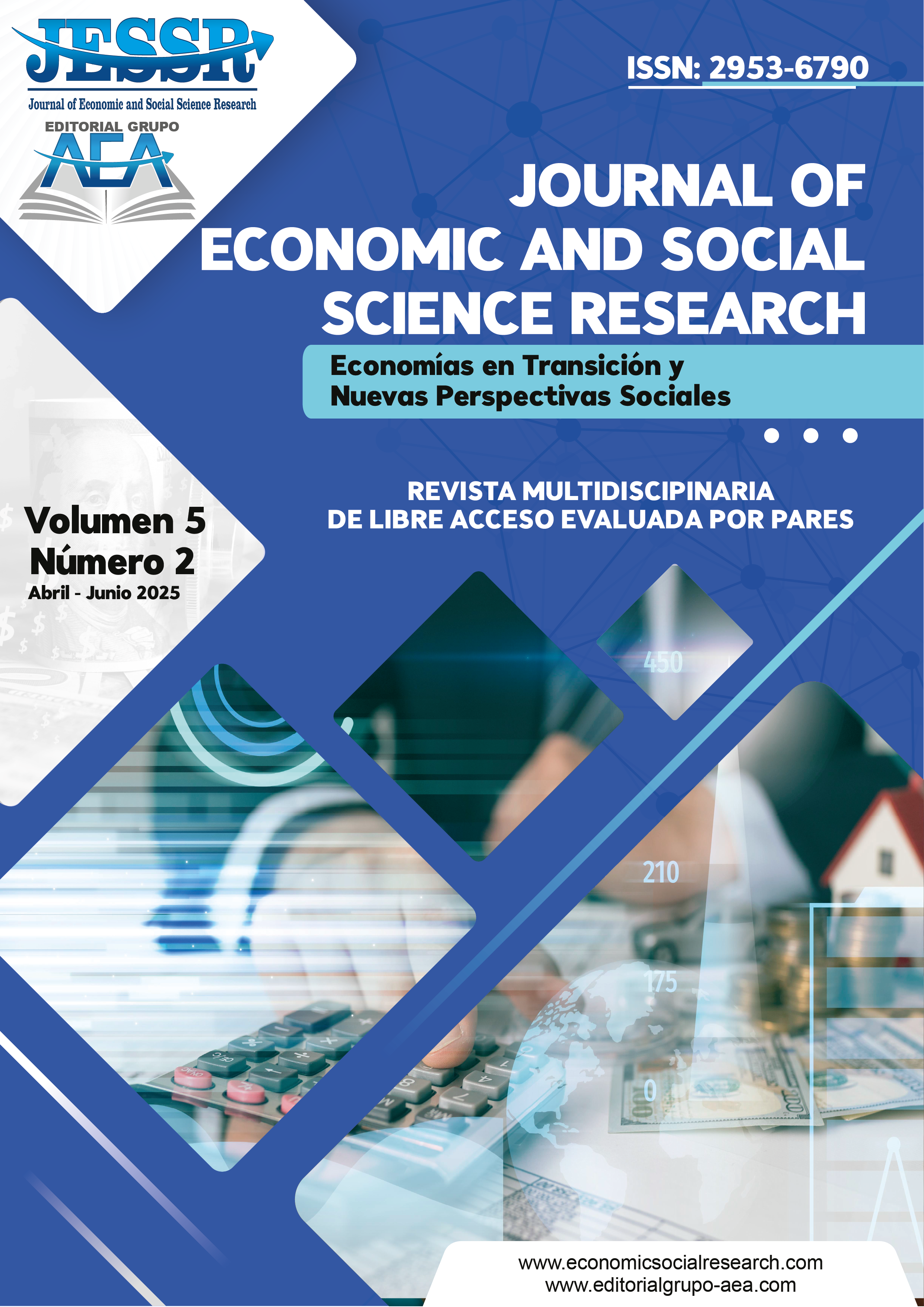Evaluation of the F5 Algorithm applied in JPEG image steganography: An analysis based on quality metrics
Main Article Content
Abstract
The study explores the application of the F5 algorithm on JPEG images to evaluate its performance in hiding information without compromising the visual quality of the images. Compression techniques based on the Discrete Cosine Transform (DCT) and matrix coding are used to minimize the perceptible alterations that may occur. The methodology includes image segmentation in 8x8 pixel blocks, quantization of coefficients and evaluation of image quality using PSNR, MSE and SSIM metrics. The experiments were performed with grayscale images, hiding messages of different lengths. The results show that the algorithm maintains high values of PSNR and SSIM, ensuring that the distortion is imperceptible. An inverse relationship between message size and visual quality is observed, although without compromising image structure. The study concludes that the F5 algorithm is effective for steganography on JPEG images, but its performance is susceptible to improvement through the application of hybrid techniques such as DCT-SVD and adaptive quantization. The need to integrate neural network approaches to strengthen resistance to detection attacks is highlighted.
Downloads
Article Details
Section

This work is licensed under a Creative Commons Attribution-NonCommercial 4.0 International License.
How to Cite
References
Abdel-Aziz, M. M., Hosny, K. M., & Lashin, N. A. (2021). Improved data hiding method for securing color images. Multimedia Tools and Applications, 80(8), 12641–12670. https://doi.org/10.1007/s11042-020-10217-9 DOI: https://doi.org/10.1007/s11042-020-10217-9
Ahmed, N., Natarajan, T., & Rao, K. (1974). Discrete cosine transform. IEEE Transactions on Computers, 23(1), 90–93. https://doi.org/10.1109/T-C.1974.223784 DOI: https://doi.org/10.1109/T-C.1974.223784
Almohammad, A., & Ghinea, G. (2010). Stego image quality and the reliability of PSNR. 2010 2nd International Conference on Image Processing Theory, Tools and Applications (IPTA), 215–220. https://doi.org/10.1109/IPTA.2010.5586786 DOI: https://doi.org/10.1109/IPTA.2010.5586786
Almohammad, A., Ghinea, G., & Hierons, R. M. (2009). JPEG steganography: A performance evaluation of quantization tables. Proceedings of the International Conference on Advanced Information Networking and Applications (AINA), 471–478. https://doi.org/10.1109/AINA.2009.123456 DOI: https://doi.org/10.1109/AINA.2009.67
Banik, B. G., & Bandyopadhyay, S. K. (2016). Implementation of image steganography algorithm using scrambled image and quantization coefficient modification in DCT. Proceedings of 2015 IEEE International Conference on Research in Computational Intelligence and Communication Networks (ICRCICN), 400–405. https://doi.org/10.1109/ICRCICN.2015.7434263 DOI: https://doi.org/10.1109/ICRCICN.2015.7434272
Baziyad, M., Rabie, T., & Kamel, I. (2021). Toward stronger energy compaction for high capacity DCT-based steganography: A region-growing approach. Multimedia Tools and Applications, 80(6), 8611–8637. https://doi.org/10.1007/s11042-021-123456 DOI: https://doi.org/10.1007/s11042-020-10008-2
Brūzgienė, R., Venčkauskas, A., Grigaliūnas, & Petraška, J. (2024). Enhancing steganography through optimized quantization tables. Electronics (Switzerland), 13(12). https://doi.org/10.3390/electronics13123456 DOI: https://doi.org/10.3390/electronics13122415
Fridrich, J. (2009). Steganography in digital media: Principles, algorithms, and applications. Cambridge University Press. DOI: https://doi.org/10.1017/CBO9781139192903
Hendrych, J., & Ličev, L. (2020). Advanced methods of detection of the steganography content. Lecture Notes in Electrical Engineering, 554, 484–493. https://doi.org/10.1007/978-3-030-554-1_12 DOI: https://doi.org/10.1007/978-3-030-14907-9_47
Jiang, C., Pang, Y., & Xiong, S. (2014). A high capacity steganographic method based on quantization table modification and F5 algorithm. Circuits, Systems, and Signal Processing, 33(5), 1611–1626. https://doi.org/10.1007/s00034-014-9739-z DOI: https://doi.org/10.1007/s00034-013-9703-3
Lin, C.-H., Hong, W., & Su, G.-Z. (2024). Adaptive sorting-based data hiding scheme for JPEG images. Lecture Notes in Electrical Engineering, 1217, 288–293. https://doi.org/10.1007/978-3-030-1217-1_23 DOI: https://doi.org/10.1007/978-981-97-4182-3_37
Lu, C., Wang, H., & Li, S. (2015). Optimized quantization tables for DCT-based steganography. Multimedia Tools and Applications, 71, 12641–12670. https://doi.org/10.1007/s11042-014-2410-7 DOI: https://doi.org/10.1007/s11042-014-2410-7
Petitcolas, F. A., Anderson, R. J., & Kuhn, M. G. (1999). Information hiding--a survey. Proceedings of the IEEE, 87(7), 1062–1078. https://doi.org/10.1109/5.771065 DOI: https://doi.org/10.1109/5.771065
Sabeti, V., & Aghabagheri, A. (2023). Developing an adaptive DCT-based steganography method using a genetic algorithm. Multimedia Tools and Applications, 82(13), 19323–19346. https://doi.org/10.1007/s11042-023-123456 DOI: https://doi.org/10.1007/s11042-022-14166-3
Solak, S., Abdirashid, A. M., Adjevi, A., & Sahu, A. K. (2024). Robust data hiding method based on frequency coefficient variance in repetitive compression. Engineering Science and Technology, an International Journal, 56. https://doi.org/10.1016/j.jestch.2024.123456 DOI: https://doi.org/10.1016/j.jestch.2024.101756
Tchakounté, F., Kamdem, P. C., Kamgang, J. C., Tchapgnouo, H. B., & Atemkeng, M. (2020). An efficient DCT-SVD steganographic approach applied to JPEG images. EAI Endorsed Transactions on Industrial Networks and Intelligent Systems, 7(24), 1–13. https://doi.org/10.4108/eai.123456 DOI: https://doi.org/10.4108/eai.28-9-2020.166365
Wallace, G. K. (1991). The JPEG still picture compression standard. Communications of the ACM, 34(4), 30–44. https://doi.org/10.1145/103085.103089 DOI: https://doi.org/10.1145/103085.103089
Wang, K., Lu, Z.-M., & Hu, Y.-J. (2013). A high capacity lossless data hiding scheme for JPEG images. Journal of Systems and Software, 86(7), 1965–1975. https://doi.org/10.1016/j.jss.2013.03.123 DOI: https://doi.org/10.1016/j.jss.2013.03.083
Westfeld, A. (2001). F5-a steganographic algorithm high capacity despite better steganalysis. Lecture Notes in Computer Science, 2137, 289–302. https://doi.org/10.1007/3-540-45496-9_21 DOI: https://doi.org/10.1007/3-540-45496-9_21
Xie, X.-Z., Chang, C.-C., & Horng, J.-H. (2021). An EMD-based data hiding scheme for JPEG images. Connection Science, 33(3), 515–531. https://doi.org/10.1080/09540091.2021.123456 DOI: https://doi.org/10.1080/09540091.2020.1853055
Zeng, X., Feng, B., Xia, Z., Peng, Z., Qin, T., & Lu, W. (2024). Robust image hiding network with frequency and spatial attentions. Pattern Recognition, 155. https://doi.org/10.1016/j.patcog.2024.123456 DOI: https://doi.org/10.1016/j.patcog.2024.110691





